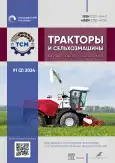1D моделирование механизма поворота адаптера зерноуборочного комбайна в поперечной плоскости
- Авторы: Джасов Д.В.1, Калиновский А.А.1
-
Учреждения:
- Гомсельмаш
- Выпуск: Том 91, № 2 (2024)
- Страницы: 207-215
- Раздел: Теория, конструирование, испытания
- URL: https://journals.rcsi.science/0321-4443/article/view/262683
- DOI: https://doi.org/10.17816/0321-4443-623797
- ID: 262683
Цитировать
Полный текст
Аннотация
Введение. При работе кормоуборочных и зерноуборочных комбайнов для выполнения технологического процесса с минимальными потерями важным условием является способность поддержания заданной высоты среза адаптером. В системах копирования поверхности поля используются системы продольного и поперечного копирования. Несогласованная работа этих механизмов может приводить к снижению качества уборки технологического продукта и повышенным потерям по высоте среза. Поэтому исследование работы и подбор оптимальных параметров механизмов как продольного, так и поперечного копирования является важной задачей для формирования алгоритмов их совместной работы. Характеристике работы механизмов поперечного копирования, как правило, не уделяется внимания.
Цель исследований — разработка математической модели механизма поворота адаптера в поперечной плоскости зерноуборочного комбайна для исследования его работоспособности, быстродействия и определения оптимальных параметров его компонентов.
Материалы и методы. В качестве инструмента для настоящего исследования авторами использована платформа для мультифизического моделирования Simcenter Amesim, которая зарекомендовала себя в качестве платформы для многодисциплинарного моделирования мехатронных систем.
Результаты. Создана модель механизма поворота адаптера зерноуборочного комбайна в поперечной плоскости, определены и проанализированы кинематические и силовые характеристики механизма, один из вариантов которого представлен в публикации. Анализ характеристик позволил оценить быстродействие механизма поворота адаптера, а также длину волны неровностей поверхности поля в поперечной плоскости, при которой обеспечивается удовлетворительная работоспособность.
Заключение. Разработанная математическая модель механизма поворота адаптера зерноуборочного комбайна в поперечной плоскости позволяет обеспечить оптимальные параметры компонентов системы, проводить широкий круг исследований работоспособности как системы в целом, так и отдельных ее компонентов. Представленный подход может использоваться для исследования других механизмов копирования поверхности поля, в том числе в составе системы автоматического копирования поверхности поля адаптером зерноуборочного комбайна.
Полный текст
Открыть статью на сайте журналаОб авторах
Дмитрий Викторович Джасов
Гомсельмаш
Автор, ответственный за переписку.
Email: dmitrok1@gmail.com
ORCID iD: 0009-0000-7135-5624
SPIN-код: 8840-4570
аспирант, ведущий инженер-конструктор — руководитель сектора конструкторско-исследовательского отдела «Динамика, прочность, аналитическая надежность» Научно-технического центра комбайностроения
Белоруссия, ГомельАлександр Алексеевич Калиновский
Гомсельмаш
Email: kiodpan@gomselmash.by
ORCID iD: 0009-0003-7090-1744
SPIN-код: 2101-0000
магистр техн. наук, ведущий инженер-конструктор конструкторско-исследовательского отдела «Динамика, прочность, аналитическая надежность» Научно-технического центра комбайностроения
Белоруссия, ГомельСписок литературы
- Джасов Д.В. Обзор механизмов копирования уборочных машин. В кн.: Инновационные технологии в агропромышленном комплексе — сегодня и завтра: Сборник научных статей 6-й международной научно-практической конференции. Гомель: Научно-технический центр комбайностроения ОАО «Гомсельмаш», 2022. С.152–157.
- Шантыко А.С., Конявский А.Д., Джасов Д.В., Чупрынин Ю.В. Функциональная математическая модель механизма поперечного уравновешивания травяной жатки. В кн.: Механизация и электрификация сельского хозяйства: межведомственный тематический сборник / Национальная академия наук Беларуси, Республиканское унитарное предприятие «Научно-практический центр Национальной академии наук Беларуси по механизации сельского хозяйства». Минск: Беларуская навука, 2020. Вып. 53. С. 161–165
- Гимадиев А.Г., Грешняков П.И., Синяков А.Ф. LMS Imagine.Lab AMESim как эффективное средство моделирования динамических процессов в мехатронных системах. Самара: СамНЦ РАН, 2014.
- Баханович А.Г., Михальцевич Н.Р. Моделирование процесса торможения двухколесного транспортного средства // Новости науки и технологий. 2015. № 2 (33). С.36–40
- Kliauzovich S. Analysis of control systems for vehicle hybrid powertrains // Transport. 2007. Vol. 22, N 2. P. 105–110. doi: 10.3846/16484142.2007.9638107
- Ghazaly N.M., Moaaz A.O. Hydro-Pneumatic Passive Suspension System Performance Analysis using AMEsim Software // Int. J. Vehicle Structures & Systems, 2020. Vol. 12, N 1. P. 9–12. doi: 10.4273/ijvss.12.1.02
- Siddique Md. A.A., Kim W.S., Beak S.Y., et al. Simulation of hydraulic system of the rice transplanter with AMESim software. In: Conference: American Society of Agricultural and Biological Engineers. Detroit: ASME, 2018. doi: 10.13031/aim.201800981
- Суханова А. Стать провайдером всеобъемлющих решений для системно-ориентированной разработки продуктов — вот истинная цель покупки LMS компанией Siemens // CAD/CAM/CAE Observer. 2015. № 8(100). Дата обращения: 24.11.2023. Режим доступа: http://www.cadcamcae.lv/N100/06-14.pdf
- Siemens PLM Software. Управляй переменами. Применение LMS Imagine.Lab Amesim в компании Renault // CAD/CAM/CAE Observer. 2016. № 2(102). Дата обращения: 24.11.2023. Режим доступа: http://www.cadcamcae.lv/N102/34-36.pdf
- Попов В.Б. Математическое моделирование механизма вывешивания косилки-плющилки прицепной КПП-4.2 // Вестник ГГТУ им. П.О. Сухого. 2001. № 3–4. С. 17–22.
- Попов В.Б. Формирование функциональной математической модели механизма вывешивания адаптера кормоуборочного комбайна «Полесье-3000» // Вестник ГГТУ П.О. Сухого. 2010. № 4. С. 37–44.
- Джасов Д.В. Обзор и классификация систем копирования поверхности поля в конструкциях уборочных сельскохозяйственных машин // Механика машин, механизмов и материалов. 2023. №4 (65). С.5–15.
Дополнительные файлы












